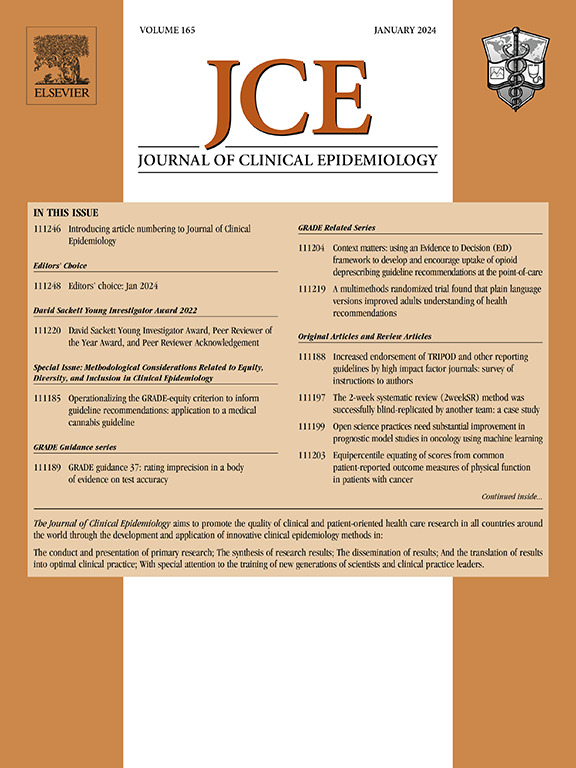Sociodemographic bias in clinical machine learning models: a scoping review of algorithmic bias instances and mechanisms
IF 7.3
2区 医学
Q1 HEALTH CARE SCIENCES & SERVICES
引用次数: 0
Abstract
Background and Objectives
Clinical machine learning (ML) technologies can sometimes be biased and their use could exacerbate health disparities. The extent to which bias is present, the groups who most frequently experience bias, and the mechanism through which bias is introduced in clinical ML applications is not well described. The objective of this study was to examine instances of bias in clinical ML models. We identified the sociodemographic subgroups PROGRESS that experienced bias and the reported mechanisms of bias introduction.
Methods
We searched MEDLINE, EMBASE, PsycINFO, and Web of Science for all studies that evaluated bias on sociodemographic factors within ML algorithms created for the purpose of facilitating clinical care. The scoping review was conducted according to the Joanna Briggs Institute guide and reported using the PRISMA (Preferred Reporting Items for Systematic reviews and Meta-Analyses) extension for scoping reviews.
Results
We identified 6448 articles, of which 760 reported on a clinical ML model and 91 (12.0%) completed a bias evaluation and met all inclusion criteria. Most studies evaluated a single sociodemographic factor (n = 56, 61.5%). The most frequently evaluated sociodemographic factor was race (n = 59, 64.8%), followed by sex/gender (n = 41, 45.1%), and age (n = 24, 26.4%), with one study (1.1%) evaluating intersectional factors. Of all studies, 74.7% (n = 68) reported that bias was present, 18.7% (n = 17) reported bias was not present, and 6.6% (n = 6) did not state whether bias was present. When present, 87% of studies reported bias against groups with socioeconomic disadvantage.
Conclusion
Most ML algorithms that were evaluated for bias demonstrated bias on sociodemographic factors. Furthermore, most bias evaluations concentrated on race, sex/gender, and age, while other sociodemographic factors and their intersection were infrequently assessed. Given potential health equity implications, bias assessments should be completed for all clinical ML models.
临床机器学习模型中的社会人口偏见:算法偏差实例和机制的范围综述。
背景:临床机器学习(ML)技术有时可能存在偏见,使用这些技术可能会加剧健康差异。关于临床机器学习应用中存在偏差的程度、最常出现偏差的群体以及引入偏差的机制,目前还没有很好的描述。本研究的目的是检查临床 ML 模型中的偏差实例。我们确定了出现偏倚的社会人口亚群(使用 PROGRESS-Plus 框架),以及报告的偏倚引入机制。 方法:我们检索了 MEDLINE、EMBASE、PsycINFO 和 Web of Science,以查找所有评估为促进临床护理而创建的 ML 算法中社会人口因素偏倚的研究。范围界定综述根据 JBI 指南进行,并使用范围界定综述的 PRISMA 扩展报告:我们确定了 6448 篇文章,其中 760 篇报告了临床 ML 模型,91 篇(12.0%)完成了偏倚评估并符合所有纳入标准。大多数研究只评估了一个社会人口因素(n=56,61.5%)。最常评估的社会人口因素是种族(n=59,64.8%),其次是性/性别(n=41,45.1%)和年龄(n=24,26.4%),有一项研究(1.1%)评估了交叉因素。在所有研究中,74.7%(n=68)报告存在偏见,18.7%(n=17)报告不存在偏见,6.6%(n=6)未说明是否存在偏见。87%的研究报告称存在针对社会经济弱势群体的偏见:结论:大多数被评估为存在偏差的 ML 算法都显示出社会人口因素方面的偏差。此外,大多数偏倚评估都集中在种族、性别和年龄上,而其他社会人口因素及其交叉因素很少得到评估。考虑到潜在的健康公平影响,所有临床 ML 模型都应完成偏倚评估。
本文章由计算机程序翻译,如有差异,请以英文原文为准。
求助全文
约1分钟内获得全文
求助全文
来源期刊

Journal of Clinical Epidemiology
医学-公共卫生、环境卫生与职业卫生
CiteScore
12.00
自引率
6.90%
发文量
320
审稿时长
44 days
期刊介绍:
The Journal of Clinical Epidemiology strives to enhance the quality of clinical and patient-oriented healthcare research by advancing and applying innovative methods in conducting, presenting, synthesizing, disseminating, and translating research results into optimal clinical practice. Special emphasis is placed on training new generations of scientists and clinical practice leaders.
 求助内容:
求助内容: 应助结果提醒方式:
应助结果提醒方式:


